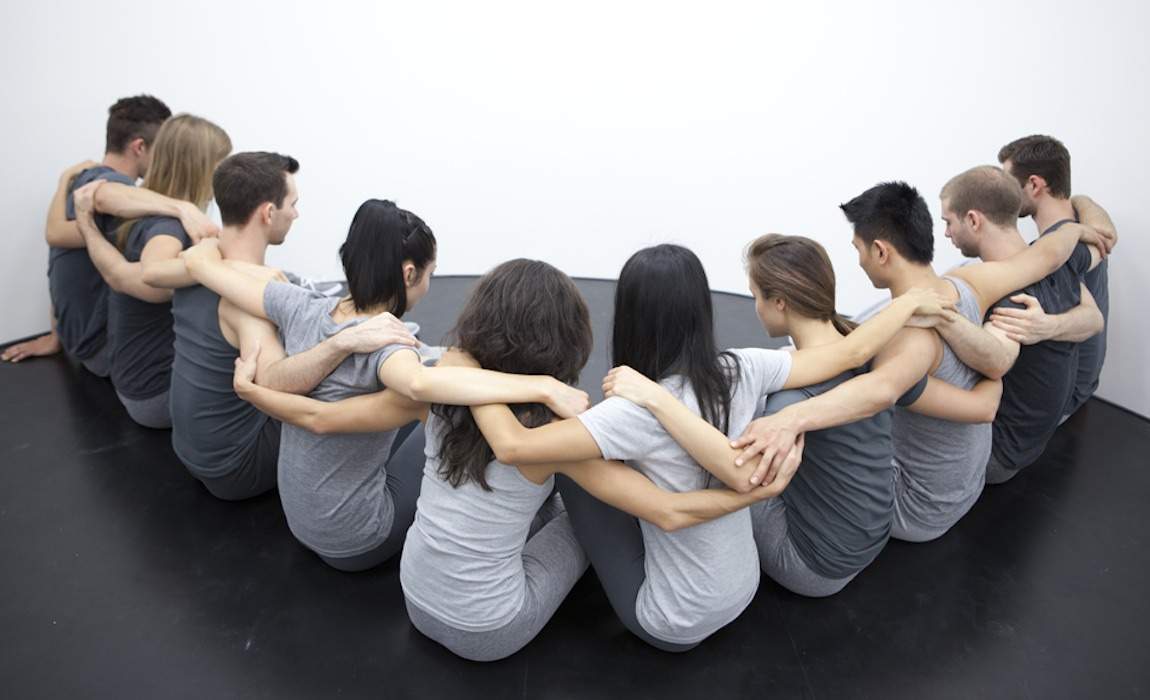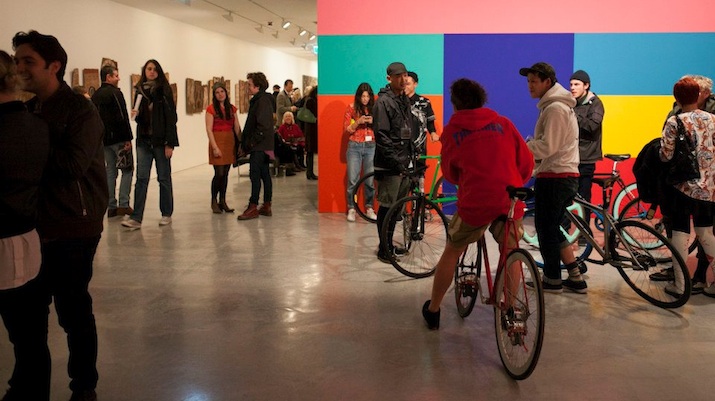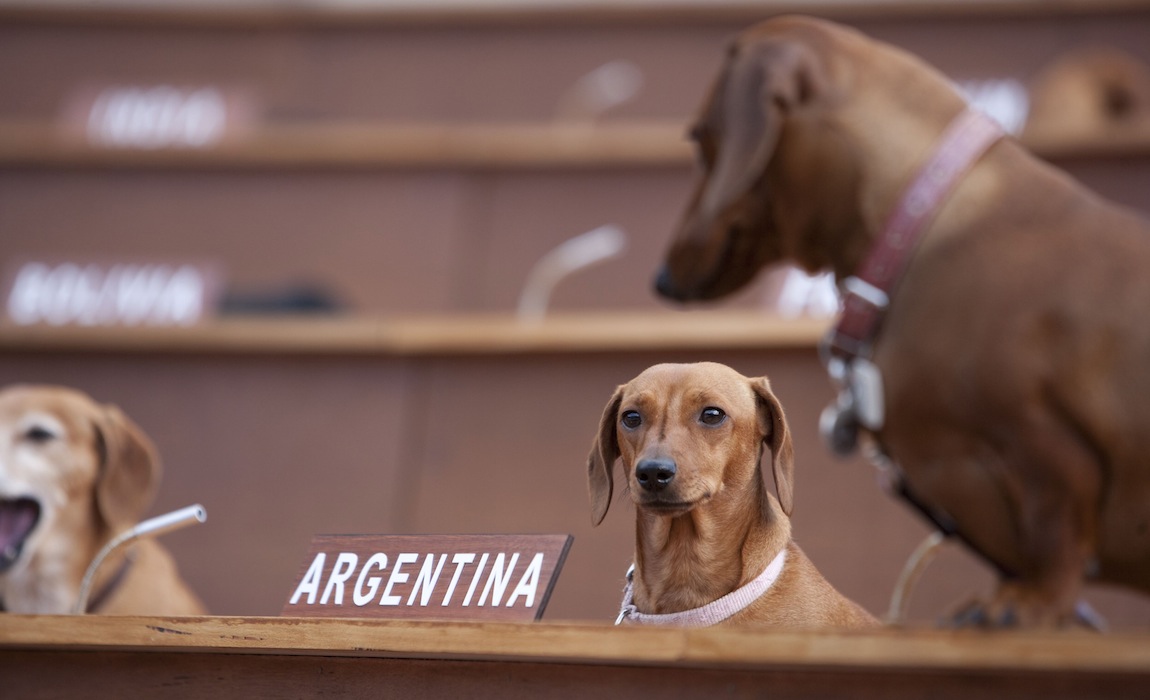How the Internet, Marina Abramovic and Dachshunds Made Performance Art Cool
What is it? Why is it? Huh?
A few years ago, it would've been hard to imagine millions of people getting excited about watching someone sleeping in a box. But two weeks ago, we all did just that, as that most sculptural of humans, Tilda Swinton, set up in New York's Museum of Modern Art for some shut-eye under glass. The performative art work, titled The Maybe, had been exhibited previously in 1995, but this time it generated a huge level of interest — and Swinton's heightened celebrity wasn't the only driver.
Performance art — these days often called live art, time-based art or just plain performance — is having a bit of a moment. Right now, thousands of Sydneysiders are queuing to experience 13 Rooms, an installation of, yes, 13 rooms, each containing a flight of performative fancy from one of 13 internationally renowned artists. Once in, they're swapping their personal belongings for those of others, negotiating a revolving door made of people and comprehending a live person floating on air. The art form is easy to make fun of (sometimes brilliantly, as in this Portlandia clip), but that's partly because it's fun and easy to engage with.
So why have we entered the time of performance art? Here are a few of the factors behind the rise.
1. Art parties
The last time performance art was at its heights was in the 1960s, when Andy Warhol's 'happenings' were a major way of doing cultural business. These were events at his famous Factory studio and one of history's main moments in which artists from all different disciplines were invited to mingle — along with people who just liked to party. There might be paintings on one wall, video projections on another, the Velvet Underground everywhere. "What's happening now is happenings — where music, dancing, movies, everything happens at once and assaults all the senses," wrote Newsweek in its Pop issue in 1966.
Sound familiar? Minus some orgies and taboo breaking, it's not unlike the current mode for art parties like Jurassic Lounge, ARTBAR or Next Wave events. Performance art — based, as it usually is, on a strong central concept that can be communicated within minutes, if not seconds — is the sort of thing that can thrive in a hullabaloo. Even if it's a durational performance whose real meaning will only become known over days, you can still just engage for 30 seconds and move on to the next thing. It also helps that much like then, we're into interdisciplinarity at the moment — the Australia Council even has a separate funding body for it, the Inter-Arts office. More on that in point two.
2. A response to digital
The internet is big, you guys. Photorealistic blending of oil paint is great, but how much can it tell us about our technologically precipitous times? Let's throw everything we have at that moral puzzle, is the thinking: film, video games, live art, big ideas. A blend of sculpture and theatre, performance is one of the quintessential interdisciplinary arts.
There are two particular aspects of it that suit our ubiquitously digital times: interactivity and the idea of 'absolute presence'. Interacting with stuff is our modus operandi now, and we don't want to stop when we put down our devices. Although it doesn't usually put you on the spot in the dreaded 'public participation' way, performance art is essentially interactive. A performer and an observer (performer #2?) in one space cannot help but have an effect on each other. And then there's almost the converse quality: sometimes we just want to cut the digital tether and just be in one place, without distraction (like mindfulness. But arty). Seeing performance art is a way of having an experience that you know is personal, private, fleeting, immediate and real. It's kind of nice.
3. Marina Abramovic
Marina Abramovic has been a presence in popular culture for a while now — she was on Sex and the City back in 2003, when Carrie dated an artist. But her 2010 MoMA show, The Artist Is Present, captured public attention as few art world things have. With the still-entertaining Tumblr Marina Abramovic Made Me Cry, she basically reached meme status through the act of sitting. Since then a documentary about the exhibition and her weird mutual obsession with that other interdisciplinary something, James Franco (she's apparently making a movie about him) have continued to endear and fascinate. (In the above clip, she has a surprise reunion with her ex-partner Ulay at The Artist Is Present — gah!)
4. Art gallery infiltration
Sydney's MCA is about to launch a second season dedicated to performance art, this year dubbed Workout. Previously, the Dachshund UN held there was something of a live art coup. And the MCA is not alone; traditional galleries are increasingly finding space for the oft-puzzling art form that can't be hung on the wall or put behind glass (unless it's Tilda). Melbourne's ACCA will soon host Mikala Dwyer's performance project, and last year London's Tate Modern opened the Tanks, a cavern underground that plays host to a roster of performance as well as film, sound and, of course, happenings. As Laura Cumming wrote in her Guardian review, "For the moment, the Tanks are the coolest part of the whole Tate enterprise. They have an air of freedom about them, as if anything might happen, and that comes from the ever-changing relationship between the raw building, the art and its audience."
With institutional support, this era of performance art could be a long one. Settle in.









